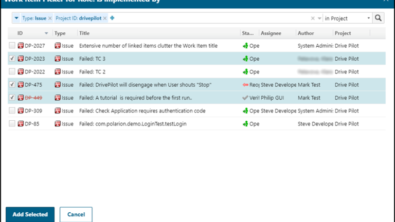ALM-PLM: Siemens Invests in Future of ALM Market by Acquiring Polarion Software
As most of you know, Polarion Software is a global world ALM leader and creator of the first 100% browser-based ALM in 2005, Polarion was also the first unified application lifecycle management (ALM) solution delivered to the market as a commercial-off-the-shelf-software (COTS) solution.
Continuing with this thought leadership, we extended our solution and delivered a successful integration of ALM with Product Lifecycle Management (PLM) solutions to create a cohesive systems development solution for our customers.

Siemens shares the Polarion vision and recognizes the incredible achievements made by our company.To best continue to deliver the ALM-PLM benefits, Siemens recently announced it will acquire Polarion Software.
Here is what Chuck Grindstaff, CEO and President of Siemens PLM Software, said (link to full press release):
“Today’s announcement is another step in Siemens’ commitment to help our customers fully realize the benefits of digitalization.By adding Polarion ALM solutions to our PLM portfolio, we are further strengthening our ability to help companies create smart, connected products.Polarion’s advanced functions integrate software specification, development, testing and simulation further into our market leading systems-driven product development environment.We are delighted to welcome the Polarion team to our organization and to integrate their leading ALM offerings into our Smart Innovation Portfolio.”
The boundaries between ALM and PLM have eroded in recent years, primarily because software has become significantly more important for successful product lifecycle development.However, ALM and PLM solutions were developed separately over time; the challenge was to create a seamless collaboration across systems, disciplines, and teams.
The benefits of ALM and PLM to link and share software and product information, across the comprehensive lifecycle, providing a holistic view of product-related processes – arequite simply immense. For example, with ALM-PLM integration, you’ll benefit from increased team member collaboration, and product quality with less systems development issues related to compliance or regulatory mandates.Manufacturers understand that software is increasingly the true value of their product and ALMis a necessary solution to complement their PLM in product development.
Every organization has different demands for how ALM and PLM should cohesively work together. Utilizing Polarion ALM-PLM integration helps increase productivity from inception to end-of-life; better quality assurance of software engineering and requirements; and full traceability.
The Polarion approach consists of five (5) levels of ALM-PLM integration:
- Link and Trace
- Change and Propagate
- Act and Communicate
- Align and Unify
- Collaborate and Report
Earlier this year, we released the first version of the Polarion ALM-Siemens Teamcenter Integration, the world’s first commercial-off-the-shelf (COTS) software for ALM-PLM integration, which supports levels 1, 2 and 3 above.For technical specifications and more details regarding the actual integration software, please click here.
Give the Teamcenter integration a closer look:
If you’d like to learn more about the benefits of ALM-PLM integration, we have white papers, videos, and much more for you to explore on the ALM-PLM section of our website.
It’s an exciting time here at Polarion Software, and we look forward to assisting you with your ALM needs in 2016!


